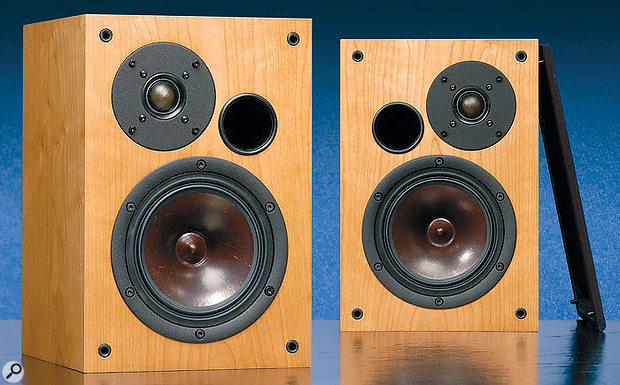 AVI's Pro Nine Plus monitors (left) have their tweeter mounting and porting asymmetrical to the main driver. This is actually relatively common, as you can see from the Acoustic Energy AE22s and the Dynaudio BM15As (below).
AVI's Pro Nine Plus monitors (left) have their tweeter mounting and porting asymmetrical to the main driver. This is actually relatively common, as you can see from the Acoustic Energy AE22s and the Dynaudio BM15As (below).
I'm considering AVI's Pro Nine Plus system for my main nearfield monitoring, partly based on the great review they got from Paul White back in September 2005 (/sos/sep05/articles/avipronine.htm). Should I be worried about the fact that the tweeter mounting and porting are both asymmetrical in relation to the main driver? Will this cause slight delay/phasing issues when placed in the classic equilateral-triangle stereo setup?
SOS Forum post
SOS contributor Mike Senior replies: Opinions differ about a lot of aspects of speaker design, as you can easily see even just from comparing the external appearance of a selection of similarly priced monitors.
 Acoustic Energy AE22 monitor.
Acoustic Energy AE22 monitor. Dynaudio BM15A.One such moot point is how important symmetrical driver placement is, and the Pro Nines are by no means the only speakers that have their tweeters skewed to one side like this. The Acoustic Energy AE22s and Dynaudio BM15As both feature this kind of setup, and are both nonetheless well-regarded. Although I've not tried these specific speakers myself, the main thing I'd be wary of in principle is that the size of the stereo sweet spot may be reduced. No matter which way you move your head (forward/back, side to side, or up/down) the potential for inter-driver phasing in the mid-range appears to me to be greater than with a more traditional vertically stacked driver configuration.
Dynaudio BM15A.One such moot point is how important symmetrical driver placement is, and the Pro Nines are by no means the only speakers that have their tweeters skewed to one side like this. The Acoustic Energy AE22s and Dynaudio BM15As both feature this kind of setup, and are both nonetheless well-regarded. Although I've not tried these specific speakers myself, the main thing I'd be wary of in principle is that the size of the stereo sweet spot may be reduced. No matter which way you move your head (forward/back, side to side, or up/down) the potential for inter-driver phasing in the mid-range appears to me to be greater than with a more traditional vertically stacked driver configuration.
Even if this theoretical concern is borne out in practice, though, the real question is how much it'll matter to you. If you're happy to stay in the sweet spot most of the time, and can check the mid-range balance with a single-driver speaker such as an Auratone (or similar), then it may not be a huge practical concern. Personally, I'd say that if you like the speakers otherwise, don't let the asymmetry be a deal-breaker.
As for the ports, again I don't think their asymmetry should really put you off, and although I find that porting in budget-level monitors can cause all sorts of low-end monitoring problems, I would imagine that these speakers are probably getting into the kind of price range where the potential problematic side-effects of the porting are kept well enough under control that you can work with them for mixing purposes. Certainly, the 90Hz low-end boundary on the published frequency-response figure leads me to suspect that the port hasn't been overhyped, as it seems to be on many budget models, and that counts for a lot in terms of accuracy.
